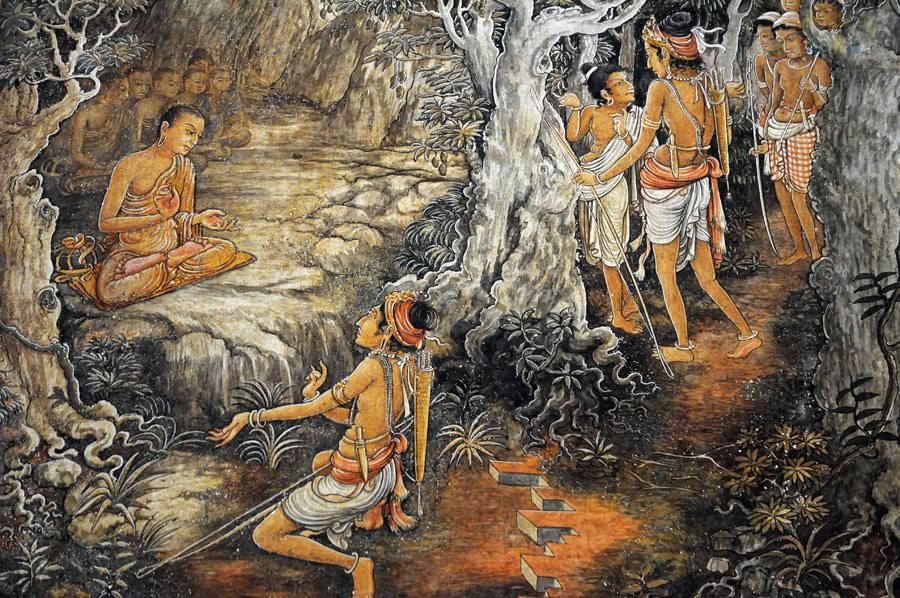The First Known IQ Test?

The conversation between a monk and a king at Mihintale.
By Ama H.Vanniarachchy
Twenty-Three centuries ago, a bhikkhu who visited Sri Lanka from India, changed the fate of this little island. He, known as Arhat Mahinda, was the son of the Mauryan emperor Asoka. Arhat Mahinda taught the teachings of the Gautama Buddha to the Sinhalese king Devanampiyatissa as he was convinced by the new philosophy and ensured rooting the teachings of Gautama Buddha on this island.
It is a known fact that the king and pre-Buddhist Sri Lanka was following a complex and rather primitive set of religious beliefs. However, the acts of Arhat Mahinda were so sustainable and practical that he was able to convince the king and his subjects to learn the teachings of the Buddha. If we look at the history of religions in the world, in almost all cases, they were spread by force, by brutal bloodshed, and by destroying pagan beliefs forcefully and mercilessly. Pagan temples and idols were demolished, practices were banned and devotees were tortured or killed. But, nothing of that sort is seen in the way the teachings of the Buddha were introduced and then successfully established in Sri Lanka.
Historians say that Arhat Mahinda is responsible for establishing or deep-rooting Buddhism in the consciousness of Sri Lankan culture and civilization. He planned the program by introducing the teachings in fine order. It was not forceful. It flowed so well; starting from the king, the royal family, and elites, and then gradually among the public.
The first step in this task was to convince the king. It is not to ‘convert’ the king to a new religion by pointing out flaws in his pagan belief. It was not by installing ignorance or fear in the mind of the king. It was by making the king understand the teachings. For this what Arhat Mahinda first did was test the king’s intelligence and intellectual capacity. He asked the king a set of questions to do so. This interesting conversation between the king and the bhikkhu is recorded in the 5th century Pali text, Mahavamsa, and many others. Modern scholars say that this set of questions seems to be a modern IQ test as it is to test the king’s ability of rational thinking and intelligence.
If so, this could be the first or one of the earliest recorded IQ tests in known history.
Today, as we observed the Poson full moon day on the 24 June, Ceylon Today Heritage will revisit Missaka Pabbata and understand how the bhikkhu tested the level of intelligence of the Sinhalese king and try to understand the purpose behind this interesting conversation.
Arrival at Mihintale….
According to the Pali chronicles, it was on a Poson full moon day that Arhat Mahinda arrived at Mihintale or Missaka Pabbata. The Sinhalese king was engaged in a game of hunting at this place. Pali chronicles say that the king before he left for Missaka pabbatha, organized a water festival for his subjects at Anuradhapura.
According to Mahavamsa this was the month of Jetha, or Jyeshtha or Jyestha which is the third month of the Hindu calendar. During this month which is the peak of the summer, a number of water festivals are held in honour of gods in relation to rain. Pabbatas or rocks are associated with rain gods in ancient Sinhalese culture. Therefore, historians believe that the king who was enjoying a game of hunting accompanied by 40,000 supporters at the Missaka pabbata, was engaged in a grand royal festival and ritual which was held in honour of rain gods. This may be a part of the religious beliefs of pre-Buddhist Sri Lanka.
While chasing after the sambar deer (a Gona, according to the Mahavamsa), the king heard someone calling him. Surprised and at the same time shocked, the king asked who it was. It was then he saw a monk in saffron robes, radiant as the sun, standing on the summit of the rock. The monk introduced himself as a follower of the Great Sage of the Sakyans, the blessed one, Gautama Buddha, and said that he was from Jambudweepa. Then the king realised this was the son of his friend, the Mauryan Emperor Asoka.
This is the tale recorded in the Pali chronicles. However, historian Prof. Mendis Rohanadheera says that it can be assumed that the King went to Mihintale accompanied by 40,000 people to welcome Arhat Mahinda and his group. Prof. Rohanadheera further explains that Aritta, the chief minister, must have played the role of the language translator during the meeting of Arhat Mahinda and King Tissa, as he stayed at Pataliputra for five months, and hence he was fluent in the foreign language.
What were the questions?
However, after the encounter between the king and the monk, an interesting conversation begins. We present to you as it is in the 14th chapter of the Mahavamsa, a 5th-century Pali text.
Monk – “What is the name of this tree, O great king?”
King – “This is a mango tree.”
Monk – “Is there another mango tree, apart from this?”
King – “There are many mango trees.”
Monk – “Are there any other trees besides this mango tree and the other mango trees?”
King – “O Lord, there are many trees, but those are not mango trees.”
Monk – “Are there other trees, apart from the other mango trees and those trees which are not mango trees?”
King – “O Lord, yes, there are; and that is this mango tree.”
The chronicle says that Arhat Mahinda was pleased with the king’s answers. He said, “O great king, you are wise.”
But he wanted to test the king’s mental capacity and intellect further. Therefore he asked the second set of questions.
Monk – “Are there kinsfolk of yours, O great king?”
King – “O Lord, there are many.”
Monk – “Are there also those who are not kinsfolk?”
King – “O Lord, there are many who are not of my own kin.”
Monk – “Are there yet any one besides the kinsfolk and not kinsfolk?”
King – “Why lord, that is me.”
Monk – “O great king, you are wise.”
At the end of this conversation, Arhat Mahinda realised the king was a shrewd man with an ability to understand and think rationally. It was after that he preached the Chulla Hatti Padopama sutta to the king and his men. After preaching Chulla Hatti Padopama sutta, he preached, Petavatthu, Vimana Wattu, Sachcha Sanyuktha, Devadutha sutta, and Bala panditha sutta in order. Scholars say that it was to make the listeners gradually realise and understand Karma and realise the truth of life and samsara.
Could this be a form of an IQ test?
Although it seems to be simple, these two sets of questions are tricky. Unless a person has the ability to think logically and be quick-witted, the questions are somewhat confusing. We hardly feel so as this conversation was included in our school textbooks, thus making it appear as a casual discussion. The depth of these questions is not emphasized in our school education nor in later studies. Hence this highly intellectual conversation is being veiled in the darkness of history.
What is an IQ test?
To understand this further, let us know what an IQ test is. IQ is formally referred to as the intellectual quotient test. An IQ test is an indication of how well one performs on mental tests. These tests can help diagnose intellectual disabilities or measure someone’s intellectual potential to help diagnose learning disabilities or to measure someone’s intelligence, or to measure a person’s reasoning ability. IQ tests can predict how well people will do in particular situations, such as thinking abstractly in science, engineering, or art. There are some IQ tests that deal with knowledge while some of them deal with memory.
While closely studying the above-mentioned two sets of questions, we assumed that it is similar to a modern IQ test which comes under the category of a test to measure one’s ‘fluid intelligence’. This is to measure how good a person is at solving complex problems that do not depend on prior information.
Fluid intelligence is a person’s ability to use logic and reason to solve a problem. This is based on times when you suddenly connect the dots to see the bigger picture. It is also to see if the person is able to think and reason abstractly and his or her ability of problem solve.
Why check the king’s level of IQ?
This could be because the Buddha has preached that the Dhamma or his teachings are only for the wise and one must understand it based on their level of intelligence. Also, Buddha has given the freedom of thinking, questioning, analysing, and rationalising to his followers. Hence, before preaching such a philosophy Arhat Mahinda tested the level of intelligence, rational thinking, abstract thinking, and the mental capacity of the king to make sure if he is able to understand the dhamma. This shows us that the teachings of Gautama Buddha are not based on blind devotion. If it was merely a religion to follow by embracing a set of rituals and reciting sacred texts, Arhat Mahinda would have done it in that way as it was easier to introduce a set of rituals to the king who was already performing a pre-Buddhist ritual. It is also clear that the teachings of the Buddha are far away from following rituals and poojas based on blind devotion or fear of the unseen mighty deities. It is a deep philosophy that the wise shall understand, following a path of non-violence, peace, and leading a simple life, while journeying towards Nibbana.
Importance of this for further studies
We take this opportunity to emphasise on the importance of these two sets of questions which we suggest as an early form of an IQ test, known in recorded history. We believe that further studies should be conducted by analysing these two sets of IQ questions.
The significance of this conversation lies in the fact of realizing what sort of philosophy was introduced to Sri Lanka by Arhat Mahinda during the 3rd century BCE. It was teaching based on understanding, deep analysing, and rational thinking. It was not merely a ‘religion’ introduced by Arhat Mahinda to the islanders, based on a set of rituals, blind devotion nor fear, or ignorance.
In retrospect, after two millennia…
Furthermore, the Pali chronicles state that the first group of bhikkhus in Sri Lanka including Arhat Mahinda and his team resided in the sixty-eight caves at Mihintale and other cave monasteries that were built all over the island. Despite the fact he was the son of the Mauryan emperor he spent his entire life in a cave, now known as the Mihindu guha at Mihintale. Soon after this, Arhat Mahinda requested her sister to come to Sri Lanka in order to establish the Bhikkhuni sangha in Sri Lanka.
All Rights Reserved.
This article was first published in Ceylon Today newspaper on 24 June 2021.
Uncategorized, Ama H.Vanniarachchy, Buddhism in Sri Lanka, IQ test, Mihintale, Sri Lankan archaeology, SRI LANKAN HISTORY
